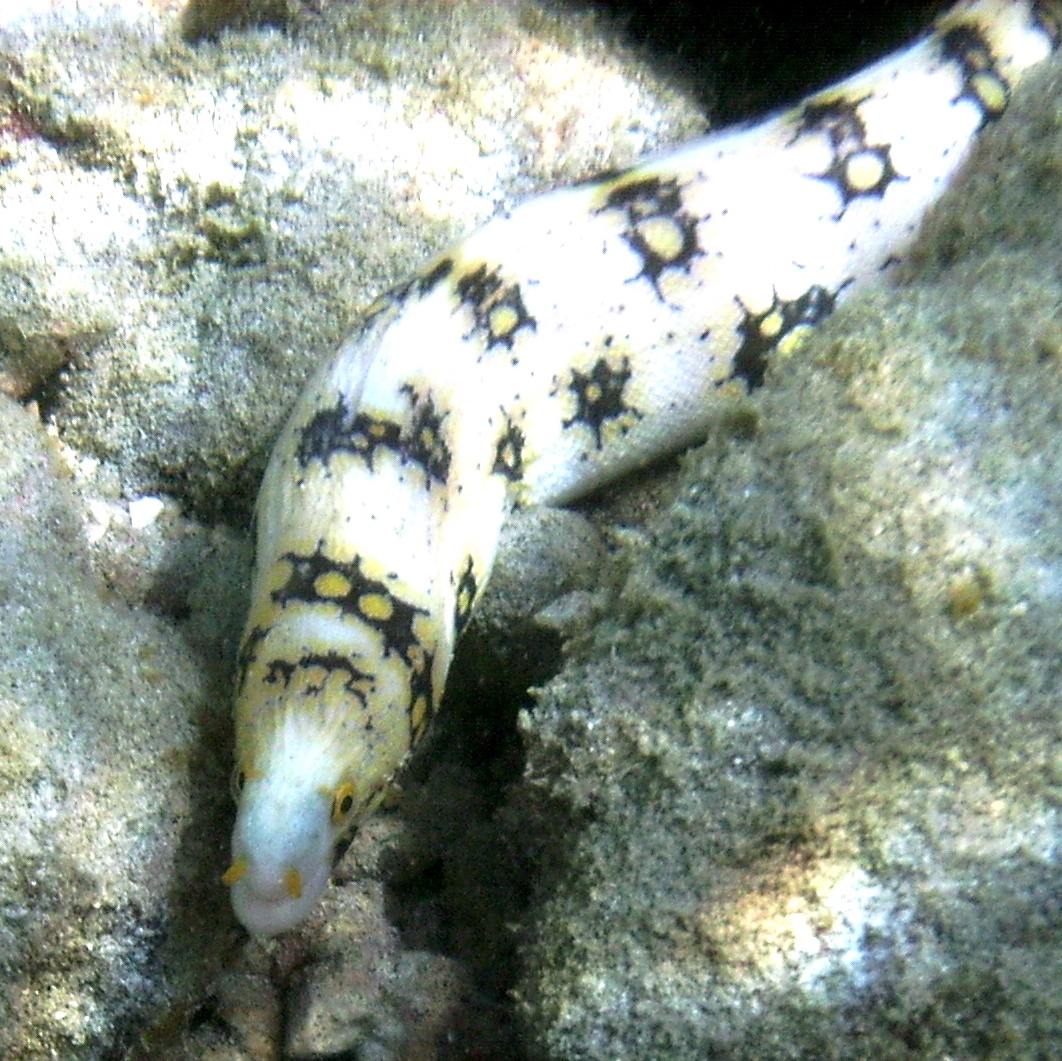Published in the Ocean Watch column, Honolulu Star-Advertiser © Susan Scott
March 7, 2008
Last week, Oregon reader Jason e-mailed: “While visiting Captain Cook monument (Kealakekua Bay) on the Big Island, my daughter spotted a snakelike eel. I captured some video of it in the shallows. Can you help me identify it? (And the black fish hiding in a crack.) Can I send you a short clip of it swimming? Thanks.”
I’ve watched Jason’s clip at least a dozen times now and still enjoy it. Packed into this 18-second video is the essence of marine sanctuaries.
At first glance the movie shows a snowflake moray winding leisurely in and out of the crack of a coral ledge, giving a good view of its whole body. This is typical of snowflake eels. They swim out in the open during the day more than other morays, and this behavior makes them seem more abundant than they are. Other moray species far outnumber them.

Small snowflake eel, Hanauma Bay
Snowflake morays grow to 30 inches long, but don’t worry about close encounters with them. Unlike most moray eels, snowflakes have molarlike teeth, useful in crushing their favorite food, crabs. Also, these eels are meek. One Hawaii author writes, “A more docile eel than the snowflake can probably not be found.”
Snowflake eels, named for the patterned blotches on their bodies, begin their lives as females and later turn into males.
The hiding fish Jason refers to is a black durgon, also called a black triggerfish.
Black durgons sometimes look all black but other times appear dark greenish gray with black and blue lines. I once thought this was a trick of the light, but not so. The fish can turn this coloring on and off, depending on its need to blend in.
About 70 percent of the black durgon’s diet is algae; the rest is animal plankton.
Triggerfish get their name from a special fin on their backs that can lock in place. When startled, the fish backs into a hole, sometimes so small the animal has to squeeze in. There, the triggerfish pokes its back fin into a crack, locks it and waits for the danger to pass.
When a triggerfish has locked itself in a small space, it’s extremely hard to pull it out. I once met a marine biologist who studied triggerfish, and as an experiment, he pulled as hard as he could on a holed-up triggerfish to see what happened. The fish died rather than let go.
(Never try this. It hurts the fish and could hurt you. Triggerfish have sharp teeth.)

I thought it interesting to see a triggerfish and snowflake moray in the same hole, but then I noticed something else there. When I looked closer I could hardly believe my eyes. A conger eel was in there, too. Its head pops up next to the triggerfish for just a few seconds and then ducks back into hiding.
Conger eels are not morays, but have similar habits, hunting for small fish and invertebrates at night. Hawaii’s common conger, called the mustache conger, is brownish gray and has small teeth and a fold of skin on the mouth that looks like a mustache.
Besides a triggerfish, a moray and a conger eel, a child’s voice in Jason’s video says in the background, “Look, next to the unicornfish — a sea snail!”
Kealakekua Bay has been protected from fishing since 1969, and it shows. You don’t even have to get in the water there to see Hawaii’s marine life at its finest.
It’s a great place to make a movie.
Here’s the video that sparked this column courtesy of Jason Robison.
Photos courtesy of Scott Davis. Taken at Hanauma Bay 3/20/2006 in the “swimming pool” in two feet of water. The eel was small, only 8 inches or so.